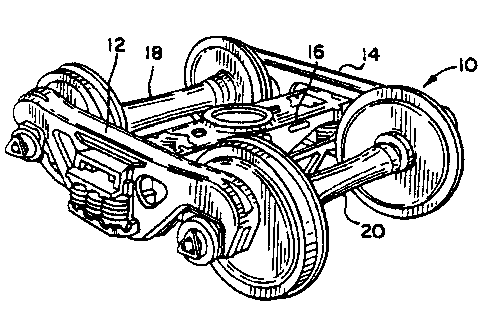Some of the information on this Web page has been provided by external sources. The Government of Canada is not responsible for the accuracy, reliability or currency of the information supplied by external sources. Users wishing to rely upon this information should consult directly with the source of the information. Content provided by external sources is not subject to official languages, privacy and accessibility requirements.
Any discrepancies in the text and image of the Claims and Abstract are due to differing posting times. Text of the Claims and Abstract are posted:
| (12) Patent: | (11) CA 2275070 |
|---|---|
| (54) English Title: | RAILWAY TRUCK SIDEFRAME WITH REINFORCED COLUMNS |
| (54) French Title: | LONGERON DE BOGIE AVEC COLONNES RENFORCEES POUR WAGONS-MARCHANDISES |
| Status: | Expired and beyond the Period of Reversal |
| (51) International Patent Classification (IPC): |
|
|---|---|
| (72) Inventors : |
|
| (73) Owners : |
|
| (71) Applicants : |
|
| (74) Agent: | GOWLING WLG (CANADA) LLP |
| (74) Associate agent: | |
| (45) Issued: | 2002-06-11 |
| (22) Filed Date: | 1999-06-17 |
| (41) Open to Public Inspection: | 1999-12-26 |
| Examination requested: | 1999-06-17 |
| Availability of licence: | N/A |
| Dedicated to the Public: | N/A |
| (25) Language of filing: | English |
| Patent Cooperation Treaty (PCT): | No |
|---|
| (30) Application Priority Data: | ||||||
|---|---|---|---|---|---|---|
|
The present invention provides a sideframe for use in a traditional three
piece railway
freight car truck comprising a pair of laterally spaced sideframes supporting
a bolster
extending between the sideframes. Each sideframe comprises an elongated top
compression
member, two diagonal compression members extending generally downwardly at
acute angles
from near the ends of the top compression member, and a bottom member joining
the other
ends of the diagonal tension members. Two column members also extend
vertically between
the bottom member and the top compression member. Such column members are
strengthened
by two ribs that extend laterally across the structure of the column member
between sidewalls
of the column member.
Note: Claims are shown in the official language in which they were submitted.
Note: Descriptions are shown in the official language in which they were submitted.

2024-08-01:As part of the Next Generation Patents (NGP) transition, the Canadian Patents Database (CPD) now contains a more detailed Event History, which replicates the Event Log of our new back-office solution.
Please note that "Inactive:" events refers to events no longer in use in our new back-office solution.
For a clearer understanding of the status of the application/patent presented on this page, the site Disclaimer , as well as the definitions for Patent , Event History , Maintenance Fee and Payment History should be consulted.
| Description | Date |
|---|---|
| Appointment of Agent Requirements Determined Compliant | 2010-06-23 |
| Revocation of Agent Requirements Determined Compliant | 2010-06-23 |
| Inactive: Office letter | 2010-06-22 |
| Time Limit for Reversal Expired | 2010-06-17 |
| Revocation of Agent Request | 2010-06-10 |
| Appointment of Agent Request | 2010-06-10 |
| Letter Sent | 2009-06-17 |
| Letter Sent | 2007-07-19 |
| Inactive: Correspondence - Transfer | 2007-02-22 |
| Grant by Issuance | 2002-06-11 |
| Inactive: Cover page published | 2002-06-10 |
| Pre-grant | 2002-03-27 |
| Inactive: Final fee received | 2002-03-27 |
| Letter Sent | 2001-10-15 |
| Notice of Allowance is Issued | 2001-10-15 |
| Notice of Allowance is Issued | 2001-10-15 |
| Inactive: Approved for allowance (AFA) | 2001-10-01 |
| Amendment Received - Voluntary Amendment | 2001-07-18 |
| Inactive: S.30(2) Rules - Examiner requisition | 2001-03-05 |
| Inactive: Cover page published | 1999-12-26 |
| Application Published (Open to Public Inspection) | 1999-12-26 |
| Inactive: First IPC assigned | 1999-08-17 |
| Inactive: Filing certificate - RFE (English) | 1999-07-22 |
| Filing Requirements Determined Compliant | 1999-07-22 |
| Letter Sent | 1999-07-22 |
| Application Received - Regular National | 1999-07-22 |
| Request for Examination Requirements Determined Compliant | 1999-06-17 |
| All Requirements for Examination Determined Compliant | 1999-06-17 |
There is no abandonment history.
The last payment was received on 2002-04-02
Note : If the full payment has not been received on or before the date indicated, a further fee may be required which may be one of the following
Please refer to the CIPO Patent Fees web page to see all current fee amounts.
| Fee Type | Anniversary Year | Due Date | Paid Date |
|---|---|---|---|
| Request for examination - standard | 1999-06-17 | ||
| Registration of a document | 1999-06-17 | ||
| Application fee - standard | 1999-06-17 | ||
| MF (application, 2nd anniv.) - standard | 02 | 2001-06-18 | 2001-04-27 |
| Final fee - standard | 2002-03-27 | ||
| MF (application, 3rd anniv.) - standard | 03 | 2002-06-17 | 2002-04-02 |
| MF (patent, 4th anniv.) - standard | 2003-06-17 | 2003-06-03 | |
| MF (patent, 5th anniv.) - standard | 2004-06-17 | 2004-06-03 | |
| MF (patent, 6th anniv.) - standard | 2005-06-17 | 2005-06-03 | |
| MF (patent, 7th anniv.) - standard | 2006-06-19 | 2006-05-30 | |
| Registration of a document | 2006-08-18 | ||
| MF (patent, 8th anniv.) - standard | 2007-06-18 | 2007-05-30 | |
| MF (patent, 9th anniv.) - standard | 2008-06-17 | 2008-05-30 |
Note: Records showing the ownership history in alphabetical order.
| Current Owners on Record |
|---|
| AMSTED INDUSTRIES INCORPORATED |
| Past Owners on Record |
|---|
| BRIAN A. TOUSSAINT |
| CHARLES MOEHLING |
| RONALD D. GOLEMBIEWSKI |
| TERREY V. HAWTHORNE |